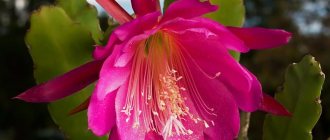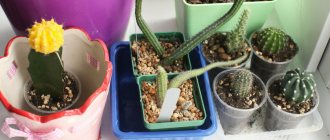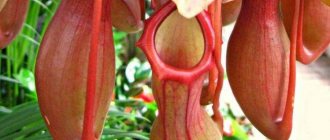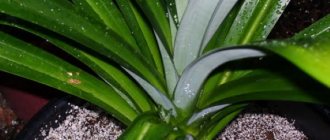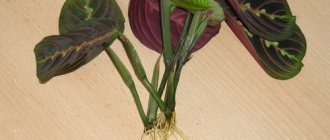Popular types of philodendron for home
The Philodendron genus includes about 900 species, but only a few of them are used as houseplants. All representatives have a similar structure and color of inflorescences, but differ in leaf shape, stem size and other characteristics.
| View | Description | Leaves |
| climbing | 200 cm. Semi-epiphyte, grows most of its life as a climbing vine. | 20-30 cm in length, reddish, velvety. They have a heart-shaped elongated shape. |
| Blushing | 150-180 cm. The stem is a non-branching vine, woody from the base. | Elongated, pointed towards the end. 25 cm long, 10-18 cm wide. Long burgundy petioles. |
| Atom | Small, has a bushy structure. | Up to 30 cm in length, shiny, covered with wax. Dark green, slightly curled, with wavy edges. |
| Guitar-shaped | Liana 200 cm tall. | 20-35 cm. Heart-shaped, elongated towards the end. Mature leaves are shaped like a guitar. |
| Warty | Medium-sized epiphyte that needs support. | Dark green with a bronze tint, heart-shaped. 20-25 cm long. Wiry. There are villi on the petioles. |
| Hastate | Long elastic vine up to 500 cm in height. | 35-45 cm. Glossy, rich green with an acidic tint. Over time, the edges become wavy. |
| Sello | Tree-like shrub plant, 100-300 cm. | Up to 90 cm in length, 60-70 cm in width. Large cuts, slightly curled. |
| Xandu | Terrestrial, stem woody. Reaches large sizes. | Round, have a lobed structure. Dark green, glossy. |
| Cobra | Compact semi-epiphyte. | 14-25 cm long. Elongated, decorative color. |
| Burgundy | A small woody branching stem. | 10-15 cm long, 8-14 cm wide. Dark green with a burgundy tint. Elongated to the ends, elliptical in shape. |
| White Marble | Medium, shrubby or epiphytic structure. | Oval, slightly elongated with a pointed end. Petioles are burgundy. Covered with white streaks. |
| Goldie | Compact branching vine with a strong root system, needs support. | Light, with a white tint. Elongated, sinewy, matte. |
| Jungle Boogie | Woody semi-epiphyte with a fleshy elastic stem. | Long, with large numerous slits, dark green, pointed tip. |
| Varshevich | Large evergreen semi-epiphyte with branching shoots. | Thin, light green, small in size. Pinnately dissected. |
| Magnificum | Medium size, dark green stem. Root system up to 10 cm long. | Dense, glossy, with wavy edges, elongated in shape. |
| Ivy-shaped | An ascending dense stem with long brownish roots. | 15-40 cm. Wide, heart-shaped, dark green, leathery. |
| Lobed | A long epiphytic vine, woody at the base. | 40-60 cm, lobed, shiny, covered with a waxy coating. |
| Radiant | Epiphytic or semi-epiphytic plant of small size. | 15-20 cm long, 10-15 cm wide. The shape changes with age from elliptical to more elongated. |
| Jellyfish | Burgundy stem, compact, easy to care for. | Light green and olive with an amber tint. Glossy. |
| Mediopicta | Compact semi-epiphyte. | Variegated, emerald, elongated towards the end. |
| Elegant | A large branched plant with a woody stem. | 45-50 cm in length. Large, light green, with deep slits. |
Varieties
Brazil (p. Scandens Brazil)
The most common representative. The stem is equipped with wide heart-shaped leaves with pointed tips. The leaf blade is green with expressive yellow spots and stripes.
Important! With a lack of lighting, the plant stretches and the leaves become smaller.
Mikans (p. Scandens Micans)
The most unpretentious representative. A small, thin-trunked vine, suitable for indoor growing and vertical gardening.
Characteristic are velvety, dark green leaves with a burgundy tint, heart-shaped.
Philodendron care
In order for the philodendron to grow healthy, it must be properly cared for.
| Factor | Spring Summer | Autumn winter |
| Location | Place in the eastern or western part of the room, where there is direct access to sunlight. | Do not place the pot near heating devices. Eliminate the possibility of drafts. |
| Watering | Moisture-loving. The soil should not dry out; the expanded clay should be kept moist. | If comfortable conditions remain, maintain regular. On cold days, do not water. |
| Humidity | 60-70%. Spray the flower once every 2-3 days; if the room is hot, increase the regularity to 2 times a day. You should also wipe the leaves with a damp cloth. | At low temperatures, avoid spraying, otherwise the plant will rot. But if the air is too dry, place a humidifier or container of water next to the pot. |
| Temperature | +22…+28 °С, regular ventilation is necessary, can also tolerate higher temperatures with appropriate humidity. | It should not fall below +15 °C, otherwise the plant will die. |
| Lighting | Needs bright light, but does not tolerate direct sunlight. | Add more daylight using phytolamps. |
Selection of container and soil, transplantation rules
The container must be wide and deep, since the philodendron horse system is long and has multiple branches; it is also necessary to make drainage holes in it for excess moisture.
You can use a substrate for orchids with the addition of peat or prepare it yourself: mix charcoal, pine needles, sand, peat, perlite and turf soil in equal proportions. For greater nutritional value, sprinkle with bone meal or horn shavings.
If the philodendron is young, it should be replanted once a year; for adult plants, once every 3-4 years is enough. As soon as roots begin to appear from the drainage holes, it is necessary to begin preparing a new container of the appropriate size.
- Place drainage (foam plastic, expanded clay) at the bottom of the pot.
- Add soil mixture on top.
- Remove the plant from the old container so as not to damage the roots.
- Place the philodendron in the center without removing the support, if any.
- Add the rest of the substrate and water thoroughly so that the soil settles and is saturated with moisture.
- The root collar does not need to be buried.
You can also use the transshipment method:
- Use a knife to separate the soil from the edges of the pot.
- Lift the philodendron out of the container along with the earthen lump.
- Move the plant to a new prepared pot.
- Add soil and water thoroughly.
Formation, support
To form a beautiful crown, you need to regularly trim dried leaves and branches. Do this in spring and summer without damaging healthy parts of the plant.
Support is needed for epiphytic species that need to ensure vertical growth. For this, a moss trunk, various stakes, grates or a damp vertical wall are used.
Watering, fertilizing
In the wild, philodendron grows in a seasonal cycle of rainfall and drought. Indoor conditions are not suitable for such moisture, but watering should be carried out in accordance with the time of year.
In spring and summer, the plant should not be watered too often; it is enough to prevent the soil from drying out.
The substrate must always remain moist. In autumn and winter, it should be reduced and carried out only after half of the soil has dried.
It is necessary to ensure that the soil does not dry out, otherwise the philodendron will die.
Feed with nitrogen-containing, phosphorus or potassium fertilizers once every 2 weeks in spring-summer, once a month in autumn-winter. Reduce the concentration of the solution by 20% from that indicated in the instructions. You can also use organic matter: pine needles, tree bark, sawdust, moss.
Table: under what conditions is it better to keep a flower at home?
| Period | Temperature | Watering | Humidity | Illumination |
| Autumn winter |
| Moderate, as the earthen clod dries out |
| Diffuse bright light |
| Spring Summer |
| Abundant and regular | Regular spraying of leaves |
Most types of philodendron tolerate normal indoor conditions well, but if you want the plants to show themselves in all their glory, you must follow these recommendations.
Philodendron propagation
Philodendron reproduces in two ways: seeds and vegetatively. But seed propagation at home is practically not practiced, since the plant blooms rarely and is not self-pollinating.
The second method is carried out in the spring-summer season.
- Cut off the shoot with 2-3 internodes with a disinfected knife.
- Treat the cut area with charcoal.
- Prepare a container with mineral substrate.
- Make small holes in the soil and place the cuttings there. The green part should remain on the surface.
- Create greenhouse conditions: regularly spray the soil, cover the container with film, maintain bright lighting, room temperature and ventilate once a day.
- After 20-25 days, transplant the plant into a standard container with ready-made soil and drainage holes.
Characteristics of culture
The genus Philodendrons (family Araceae) are perennial evergreen flowering plants. Natural habitat - tropical rainforests of Mexico, Central America, Australia. Some species grow in Asia.
The name of the genus (translated as “I love a tree”) is associated with the peculiarity of its representatives - most species are epiphytes (the stem needs support).
The above-ground part develops in the form of a vine or subshrub. Young shoots become lignified at the base as they mature. Roots can be underground or aerial. The underground part is highly branched and located superficially. Small airy, fleecy roots in the internodes are needed in order to attach to any plant, smooth thick roots - to receive nutrition and moisture from the environment.
The leaves of all varieties vary in shape and size. The smallest (about 11 cm) are in P. brewsterense, the largest (100-137 cm) are in P. gigas. The shape of the plate is so diverse that it is impossible to describe general features. The leaf can be round, ovoid, dissected, arrow-shaped and, interestingly, in the same species, the young leaf can differ in shape from the adult one. This feature is not inherent in all varieties. The color of the leaves is affected by the habitat. Most often, the upper surface of the plate is dark green, the lower surface is lighter. There are species in which the young leaf is purple, crimson-green, then its color changes.
All parts of the plant secrete a milky sap; when exposed to air, it turns brown. The tissue contains calcium oxalates, which can be dangerous if large quantities of juice or leaves are consumed. For safety, work with the flower should be done with gloves - the juice, if it gets on the skin, causes irritation.
Flowering rarely occurs when grown at home. Small flowers form a dense, usually white, vertical spadix on a short cylindrical peduncle. The cob is wrapped in a thick, fleshy blanket, similar in appearance to a hood. The color of the bedspread inside and outside in some species differs in color, in others it is almost the same. For pollination to occur, you need to have two plants that bloom at the same time.
Mistakes in caring for philodendron
| Symptoms Manifestations on leaves | Cause | Elimination methods |
| They turn yellow and dry out. | Lack of minerals, direct sunlight, dry air. | Increase the amount of watering and darken the philodendron. |
| Transparent spots appear. | Burn. | Place the plant in partial shade and cover. Spray regularly. |
| The roots are rotting. | Increased soil hardness, excess moisture, fungal infection. | In the first case, soften the soil using bark. In the second, normalize the watering regime. Physan will help against fungus. |
| They fade. | The air is too cold or damp. | Adjust air humidity to about 70%. Monitor the temperature. |
| Philodendron does not grow. They turn pale. | Substrate depletion. | Increase fertilizing or transplant the philodendron into new nutrient soil. |
| Yellow spots on the surface. | The light is too bright. | Shade or move the plant to the western part of the room. |
Reviews
It grows quite quickly; at my work this vine grew more than 4 meters. In a very bright place, its leathery, spear-shaped leaves acquire a bronze tint. The wrappers of the young leaves are very beautiful - they are almost red. A completely unpretentious plant, suitable even for northern windows. In the summer I take him out to the balcony - he feels great there even in the heat. With a lack of moisture, the leaves wither slightly, but after watering the turgor is restored. It can grow like a vine or, if pruned, like a “bush.”
Svetlana Yurievna https://irecommend.ru/content/krasneyushchii-tsvetok
The plant is very unpretentious and very grateful, stubborn in its desire to survive and grow further))) It grows slowly - about 1 cm per year.
keygen https://otzovik.com/review_476964.html
Very unpretentious! Calmly tolerates low air humidity and short-term drying out of the earthen coma. If you give it nutritious, loose, slightly acidic soil and diffused light, then there will be no problems! A very grateful and responsive plant!
sweetsvetulia https://www.flowersweb.info/forum/forum44/topic102067/message3283387/#message3283387
Diseases and pests of philodendron
| Symptom | Cause | Elimination methods |
| The roots rot and a black coating appears on them. The shoot and all the leaves dry out. | Bacterial rot. | Trim all affected parts of the plant and treat cut areas with Fitosporin. Then change the soil and disinfect the pot. It is possible to use Tetracycline (1 g per liter). |
| Black dots appear on the outside of the leaves. The stem is often covered with brown stripes. | Viral infection. | The infection cannot be treated. You need to get rid of the plant so that it does not spread to other flowers. |
| Sprouts die, leaves become covered with spots. | Shield. | Use Permethrin, Bi 58, Phosfamide, Methylmercaptophos or soap solution. |
| Green small insects on the surface of leaves, stem. Philodendron is dying. | Aphid. | Lemon juice tincture, Intavir, Actofit. |
| The stem and leaves are covered with a thin, dense white web. | Spider mite. | Water regularly, apply Neoron, Omite, Fitoverm according to the instructions. |
| Wax deposits and white spots on leaves. | Mealybug. | Remove the affected parts of the flower, remove insects, treat with Aktara, Mospilan, Actellik or Calypso. |
General description of the plant
"Philodendron" comes from the tropics. Was brought from Mexico or the Southern part of the USA. Belongs to the Araceae family. There are about 400 subspecies. The variety of sizes, shapes and all kinds of colors is very large.
Therefore, such a plant fits perfectly into any interior. Many subspecies have short branches and large leaves. Thanks to this, they look great alone. Other subspecies are creeping vines. As an emerald wall, they decorate arches and green corners.
Landing, transplant
After purchase, the flower must be quarantined for 10-14 days to protect other plants from possible infections or pests. After adaptation, you can transplant it into another container and change the soil.
The new container should be wide, with drainage holes, 6-8 cm higher than the previous one. If you take a container that is too large, moisture will stagnate between the roots, which they will not have time to consume.
Annual replanting (preferably in spring) is required only for young plants; adults are replanted at intervals of three years. It is difficult to replant a large plant, so replanting will be replaced by updating the top layer of soil (5 cm).
Age is not always an indicator for transplantation - sometimes it is performed for objective reasons:
- the components are incorrectly selected - the soil has become dense, the water stagnates;
- white streaks appear on the surface of the soil - this is a sign of the accumulation of a large amount of minerals;
- roots are visible from the drainage holes, the leaves have become small, which means the pot is small and lacks nutrients;
- soil contamination, pests.
If root treatment is not required, then it is better to replant in a coma of earth, maintaining support. Expanded clay, pebbles, and pieces of brick are used as a drainage layer. After transshipment, the voids are covered with earth and watered. If you had to wash the roots or apply fungicides, then the stem is buried to the root collar, having previously installed a support.
